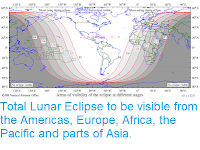A total eclipse of the Sun will be visible from parts of Chile and Argentina as well parts of the South Pacific on Tuesday 2 July 2019, with a partial eclipse visible from other parts of those countries, as well as Paraguay, Bolivia. Peru, Ecuador, Colombia, western Brazil, southern Guyana, Panama, Costa Rica, southern Nicaragua, the Galapagos Islands, Pitcairn Island, French Polynesia, Kiribati, the Cook Islands, the Marshal Islands and Samoa. The event
will occur between 4.55 pm and 9.50 pm GMT.
The
path of the 2 July 2019 Solar Eclipse. The total eclipse will be
visible along the central dark grey path. A partial eclipse will be
visible from the shaded areas; in the lighters area the full eclipse
will not be visible as it will have started before dawn (west) or will
continue after sunset (east). The solid red lines are the Equator and the International Date Line, the dashed red lines are the Tropic of Cancer and Tropic of Capricorn. HM Nautical Almanac Office.
Eclipses
are a product of the way the Earth, Moon and Sun move about
one-another. The Moon orbits the Earth every 28 days, while the Earth
orbits the Sun every 365 days, and because the two Sun and Moon appear
roughly the same size when seen from Earth, it is quite possible for the
Moon to block out the light of the Sun. At first sight this would seem
likely to happen every month at the New Moon, when the Moon is on the
same side of the Earth as the Sun, and therefore invisible (the Moon
produced no light of its own, when we see the Moon we are seeing
reflected sunlight, but this can only happen when we can see parts of
the Moon illuminated by the Sun).
The relative positions of the Sun, Moon and Earth during a Solar eclipse. Starry Night.
However the Moon does not orbit in quite the same plane as the Earth orbits the Sun, so the Eclipses only occur when the two orbital planes cross one-another; this typically happens two or three times a year, and always at the New Moon. During Total Eclipses the Moon entirely blocks the light of the Sun, however most Eclipses are Partial, the Moon only partially blocks the light of the Sun.
How the differing inclinations of the Earth and Moon's orbits prevent us having an eclipse every 28 days. Starry Skies.
Although
the light of the Sun is reduced during an Eclipse, it is still
extremely dangerous to look directly at the Sun, and viewing eclipses
should not be undertaken without appropriate equipment.
Animation showing the shadow of the Moon at five minute intervals on Tuesday 2 July 2019. Andrew Sinclair/HM Nautical Almanac.
See also...
Follow Sciency Thoughts on Facebook.










